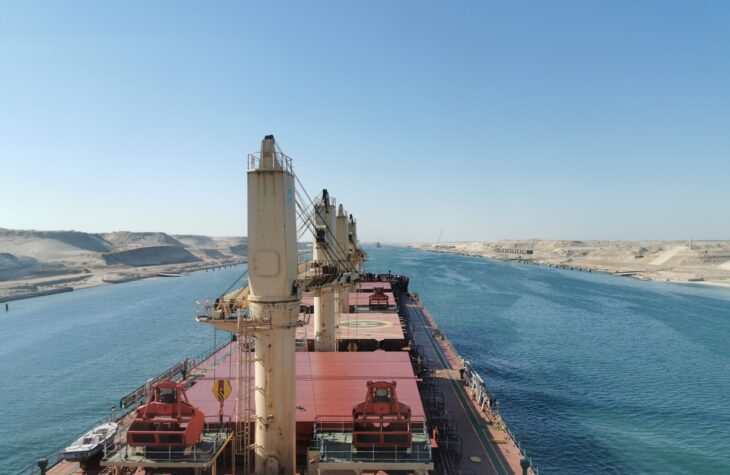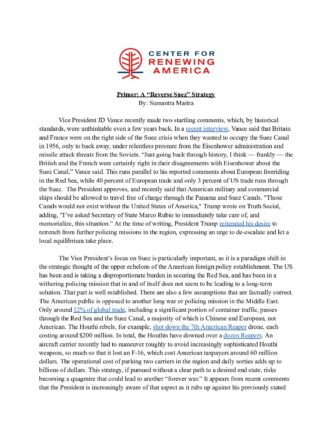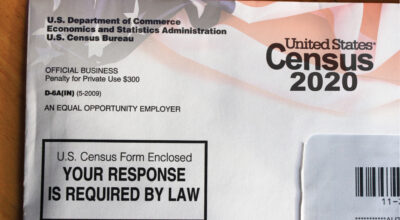
Primer: A “Reverse Suez” Strategy
Vice President JD Vance recently made two startling comments, which, by historical standards, were unthinkable even a few years back. In a recent interview, Vance said that Britain and France were on the right side of the Suez crisis when they wanted to occupy the Suez Canal in 1956, only to back away, under relentless pressure from the Eisenhower administration and missile attack threats from the Soviets. “Just going back through history, I think — frankly — the British and the French were certainly right in their disagreements with Eisenhower about the Suez Canal,” Vance said. This runs parallel to his reported comments about European freeriding in the Red Sea, while 40 percent of European trade and only 3 percent of US trade runs through the Suez. The President approves, and recently said that American military and commercial ships should be allowed to travel free of charge through the Panama and Suez Canals. “Those Canals would not exist without the United States of America,” Trump wrote on Truth Social, adding, “I’ve asked Secretary of State Marco Rubio to immediately take care of, and memorialize, this situation.” At the time of writing, President Trump reiterated his desire to retrench from further policing missions in the region, expressing an urge to de-escalate and let a local equilibrium take place.
The Vice President’s focus on Suez is particularly important, as it is a paradigm shift in the strategic thought of the upper echelons of the American foreign policy establishment. The US has been and is taking a disproportionate burden in securing the Red Sea, and has been in a withering policing mission that in and of itself does not seem to be leading to a long-term solution. That part is well established. There are also a few assumptions that are factually correct. The American public is opposed to another long war or policing mission in the Middle East. Only around 12% of global trade, including a significant portion of container traffic, passes through the Red Sea and the Suez Canal, a majority of which is Chinese and European, not American. The Houthi rebels, for example, shot down the 7th American Reaper drone, each costing around $200 million. In total, the Houthis have downed over a dozen Reapers. An aircraft carrier recently had to maneuver roughly to avoid increasingly sophisticated Houthi weapons, so much so that it lost an F-16, which cost American taxpayers around 60 million dollars. The operational cost of parking two carriers in the region and daily sorties adds up to billions of dollars. This strategy, if pursued without a clear path to a desired end state, risks becoming a quagmire that could lead to another “forever war.” It appears from recent comments that the President is increasingly aware of that aspect as it rubs up against his previously stated position as a peace candidate opposed to such never-ending policing missions across the globe in theaters of tertiary interests, and as he seeks to find a diplomatic solution.
However, the broader question is one of grand strategy. While “freedom of the seas” remains the founding principle of the US Navy, without an endgame or a strategy towards the establishment of order and security in the theater of conflict, a punitive conflict turns attritional against an entrenched, well-hidden tribal enemy in a fixed terrain. That strategy is myopic and constitutes spending expensive stockpiles of weapons on marginal theaters, leading to a hollowing out of the American arsenal needed ahead of a potential great power rivalry in Asia. It is obvious why President Trump wants to break out of this do-loop of failed policy advanced by prior administrations and advisors. It is also ahistorical. The Barbary pirates, for example, were not defeated due to the British-Dutch bombardment or Thomas Jefferson’s naval war, and were only pacified with the French conquest and pacification of North Africa.
The Houthi military forces are estimated to be around 350,000 men. Manpower is their most significant advantage. The Houthi aerial assets are decimated, and fast attack boats are mostly neutralised due to the US-UK strikes and US naval presence. Manpower availability is leading to a strong replenishment of Houthi forces. A recent operational report states: “The strengths shown by the Houthi military at the present time are significant. The movement mobilized a large number of troops during the conflict, reportedly as many as 167,000 new troops, further offsetting its extensive garrisoning requirements. Exploitation of strong Yemeni sympathy for the Palestinians has added to the recruiting potential of the Houthi movement, which already had a powerful military human resources system.”
There are three options in front of the US: the first option being punitive strikes, towards “compellence,” which in international relations means that a state coerces an adversary to follow a certain path, after a preferably one-time heavy punitive or retributive action. It cannot be more than once or twice, as one cannot repeatedly use punitive strikes, as their effectiveness decreases with constant use. And in an asymmetric conflict, the use of expensive defense (by the US) against cheap hit-and-run offense (by the Houthis) is imprudent. Deterrence, on the other hand, is not an option, as we cannot deter the Houthis. They have proven to be resilient and have demonstrated a high pain threshold.
A second option might be an occupation and pacification force, either a European “coalition of the willing” facilitated by America, or a multinational mercenary force or company. The US has no strategic reason, no appetite to go for a ground invasion and occupation of Yemen. The middle ground is a “coalition of the willing,” consisting primarily of European troops based long term, bankrolled by Gulf money, to secure the region. The US can provide intelligence and even logistics commensurate with our limited interest, but it cannot take part in any ground operation. The manpower could be supplied by Europeans whose trade depends on the route, either by a state-based coalition or mercenary companies based in Europe. The US could work towards facilitating this grand-bargain with Europe, or the Middle East, where ground troops are provided by those whose commercial stakes in the region are higher than the Americans. It would also mean that the US would remain engaged in operationalizing this coalition, but only as a third party, without direct engagements with the Houthis and direct losses.
The third option is for President Trump to work out a deal with the Houthis directly in the form of a bilateral agreement to protect US interests specifically, which, at the time of this publication, appears to be what he is doing. This is a legacy building opportunity for the Trump administration to demonstrate its deal-making and coalition-building prowess. This is admittedly an out-of-the-box solution, but it offers a prudent counter strategy that reverses an earlier error, one where, in this case, the security of a volatile region was provided by treaty allies. Reportedly, even Eisenhower was regretful of his Suez decision. It is perhaps an appropriate time to reverse it.





